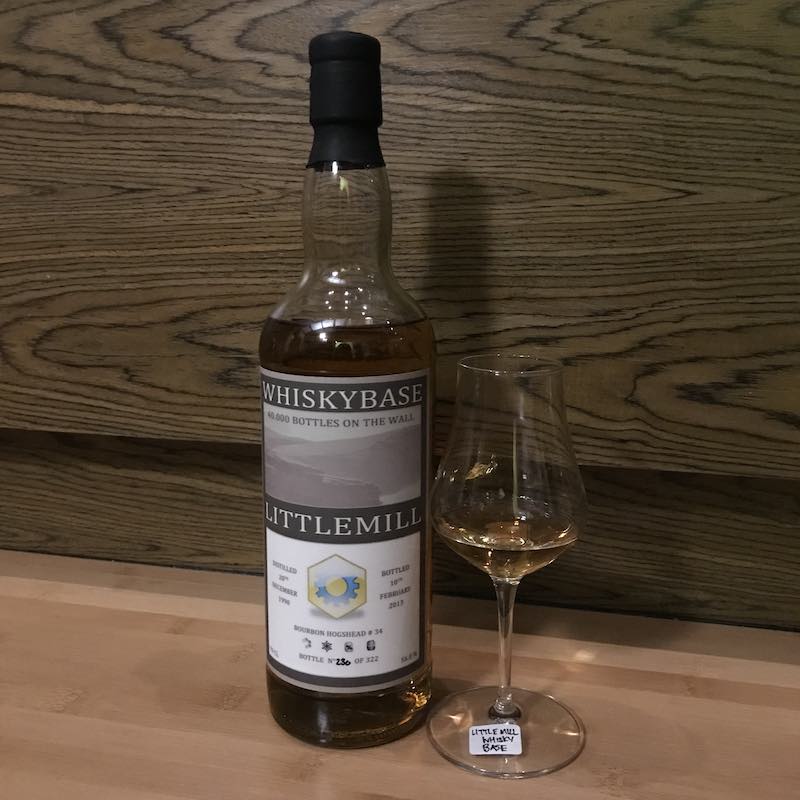Latest News
Kitchen Chat and more…
Kitchen Chat and more…

Some of you may know that I have a strong love for Littlemill. I never passed a chance to try new expressions from this closed distillery. I was again, given an opportunity recently, when I got to taste a Littlemill.
This expression is distinctive on its own. It is a bottling from WhiskyBase, in celebration of their 40,000 bottles on the wall. Matured in a bourbon hogshead, it is a 22 years old whisky distilled on 20th Dec 1990 and bottled 10th Feb 2013. Not quite a 23 years old whisky, so as per SWA’s rules, its label reads 22 years old.
Let’s dive straight into the notes!
Colour: Bright Gold
ABV: 56%
Nose: Hmm…a typical Lowlands nose with aromatic dried grass. Floral and perfumey, almost like sniffing a particular brand of perfume. Sweet pears, melons and berries dance gracefully in the nose. Warm spice lurks underneath, waiting for its turn to dance. (18/20)
Palate: Sweet fruits – pears, apples, melons and berries – explode in the mouth. The sweet overtones bounce all over with warm spices catching up in the background. The floral, grassy notes come last, rounding up the perfect and typical Littlemill notes. Warm spice tingles in the back of the throat pleasantly. (18/20)
Finish: Medium finish with dried grassy notes that become herbaceous after a while. Sweet and perfumey all the way, the finish boasts pleasant spice that lingers comfortably while it lasts. (17/20)
Body: This is a typical Littlemill that boasts the usual grassy notes, but what is worth noting here is that instead of the fresh grass that we usually find in Littlemill, this expression features grassy notes of dried grass! The fruitiness is beautiful and welcoming to anyone who is a Lowlands fan. Excellent mix of spice, fruits and grassiness to make an unforgettable whisky. While it does not have the most exciting profile, it has the strength of the character from Littlemill Distillery. (37/40)
Total Score: 90/100
Geek Flora: I love this! It features the characteristics of Littlemill without taking on too much character from the bourbon hogshead. I simply adored the grassiness of this dram!
Geek Choc: Well, it is nice, but I think I prefer something a little sweeter. A bourbon hogshead is too mild for me. Maybe a sherry cask Littlemill will do the trick!
All of us are victims of this age-old problem – the cork breaks when we are opening a bottle of our favourite whisky. This issue is especially prevalent in older bottles simply due to age. Needless to say, we are all frustrated with this recurring challenge! What are some of the best ways to remove a broken cork from our whisky bottles?
If the broken cork is just slightly below the open neck of the bottle, it is easiest to use a corkscrew to remove the broken piece. Use the corkscrew the same way that you would when opening a wine bottle, and you should have the broken cork out of the bottle soon enough!
Sometimes, the corkscrew is not delicate enough to do the job, and you will need a better idea. Find a long nail (as long as possible) and make sure it is clean. Screw it slowly into the broken cork, just like how you operate a manual corkscrew. The trick is to pull the long nail a little after screwing it into the cork so that you get a tight grip. Then use piler to slowly but steadily remove the broken cork out of the bottle.
When a corkscrew or a nail is not available, grab a flat blade knife from the kitchen. This is an operation only for the nimble fingers, so be safe when you are doing it. Insert the flat knife into the cork near the cork’s edge and the neck of the bottle. Be careful not to stick the knife into the centre of the cork as you need the neck of the bottle as some form of leverage. Once you insert the blade reasonably deep into the cork, start turning the knife in circular motions. The trick here is to pull upwards as you turn so that you pull up the cork even as you turn the knife in circles. Once you can grip the cork with your fingers, stop using the knife and pull the cork free with your hands.
If there is no way for you to remove the broken cork from the bottle, the next best thing is to push the cork into the bottle. This method requires you to have a spare glass bottle to house your whisky. To use this method, clean the debris of the broken cork so that small particles will not fall into the whisky. You may want to check the integrity of the cork as well because you do not want it to disintegrate when it falls into the bottle. Once you are sure the cork will stay in one piece, go ahead to push the cork into the bottle. After that, follow the next step.
If parts of the broken cork fall into the whisky or you push the broken cork into the whisky, you have to decanter it. Grab a clean, empty glass bottle and decanter your whisky using a sieve or strainer (for bigger debris) or a coffee filter (for tiny particles). After that, the big challenge comes – removing the bigger piece of broken cork from the newly empty bottle. One of the best ways is to use a clean plastic bag. Insert a clean plastic bag into the bottle, with the open end facing the neck of the bottle. Overturn the bottle so that the broken cork falls to the neck of the bottle. Next, blow air into the plastic bag so that the cork remains at the neck of the bottle. Then, delicately pull the plastic bag and cork out of the bottle.
For those with a steady hand and a steely gaze, you can consider using a stainless wire fashioned into a hook to remove the larger pieces of the broken cork. Ensure that the wire is hard, and use it like a fishing hook to puncture and lift the debris gently out of the bottle. It requires a ton of patience and a whole lot more skills!

Whisky drinkers do not usually have a hard time storing whisky as compared to wine drinkers. As our precious liquid stops ageing once bottled, whisky drinkers can keep their whiskies indefinitely. Well, as a broad-based theory, of course. Temperature and storage methods do affect whiskies, unfortunately, so we are here to look into how we can avoid doing the wrong things.
We need to look out for two things when storing sealed bottles. The first is temperature and the second, sunlight. Both of these affect whisky by causing chemical reactions in the whisky compounds and degrade the flavours over time. While this does not happen within a few years, but it will alter the taste after ten years or more.
The best way to store sealed bottles is in a cupboard when the light is minimal, and temperatures do not fluctuate like the stock market. Having a constant room temperature between 15 to 18 degrees Celcius is ideal. Nonetheless, we know that it is impossible for us in this part of the world to get that temperature, so keeping your whiskies in the dark cupboard is the next best thing. Otherwise, make sure that your open shelf is not facing the window to avoid heat and sunlight.
An opened bottle of whisky requires a lot more attention and careful storage as compared to a sealed one. If your bottle is more than 2/3 full, it is entirely possible that the flavours will not change for the next one year or so. What you can do is to use some parafilm to create a seal on the bottle cap or cork to preserve the flavours as much as possible.
The challenge hits when your bottle is about 1/3 full. With that much air in the bottle, the whisky will begin to oxidise. Once oxidisation starts, the whisky will change and no longer taste the way it was. For some expression, oxidisation improves the flavours, but for most others, it degrades the whisky instead.
The best way to prevent oxidisation is to invite a few friends over to your house and finish the bottle on a glorious night. If you want to keep it for yourself, you may want to drink it as quickly as you can. Alternatively, pour the remaining whisky into a smaller glass bottle with a good seal. You can then parafilm the smaller bottle after that.
You can use inert gas to remove the oxygen from the bottle before storing it for a long time. However, there is no study to verify if the inert gas will change the whisky. By theory, the inert gas will not cause any changes since they are not reactive, but nobody has verified it (at least I did not find any scientistic study on it). Some whisky drinkers in our community use inert gas, and they have not complained about taste alteration so far!
11311 Harry Hines Blvd
Dallas, TX, United States
(555) 389 976
dallas@enfold-restaurant.com
